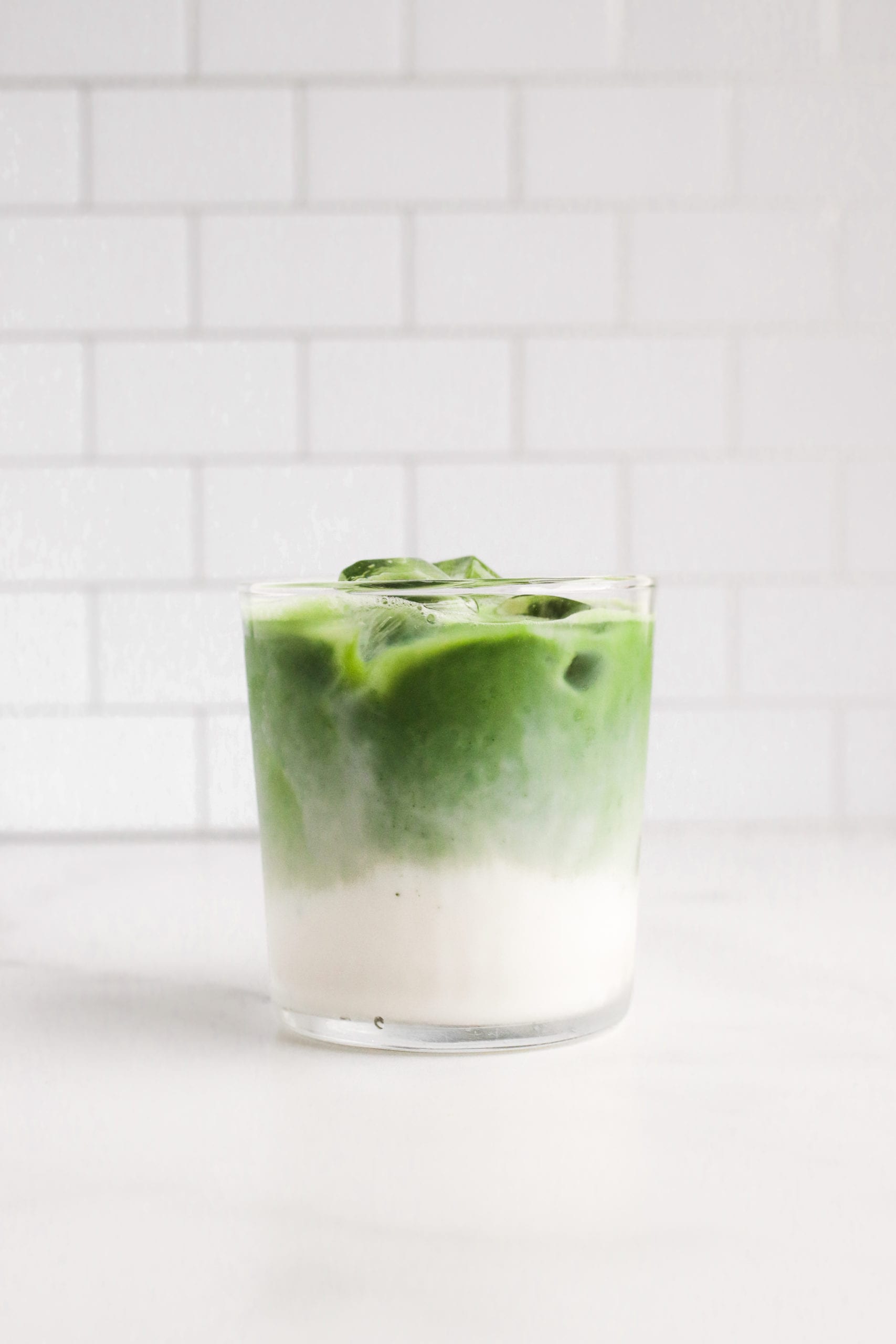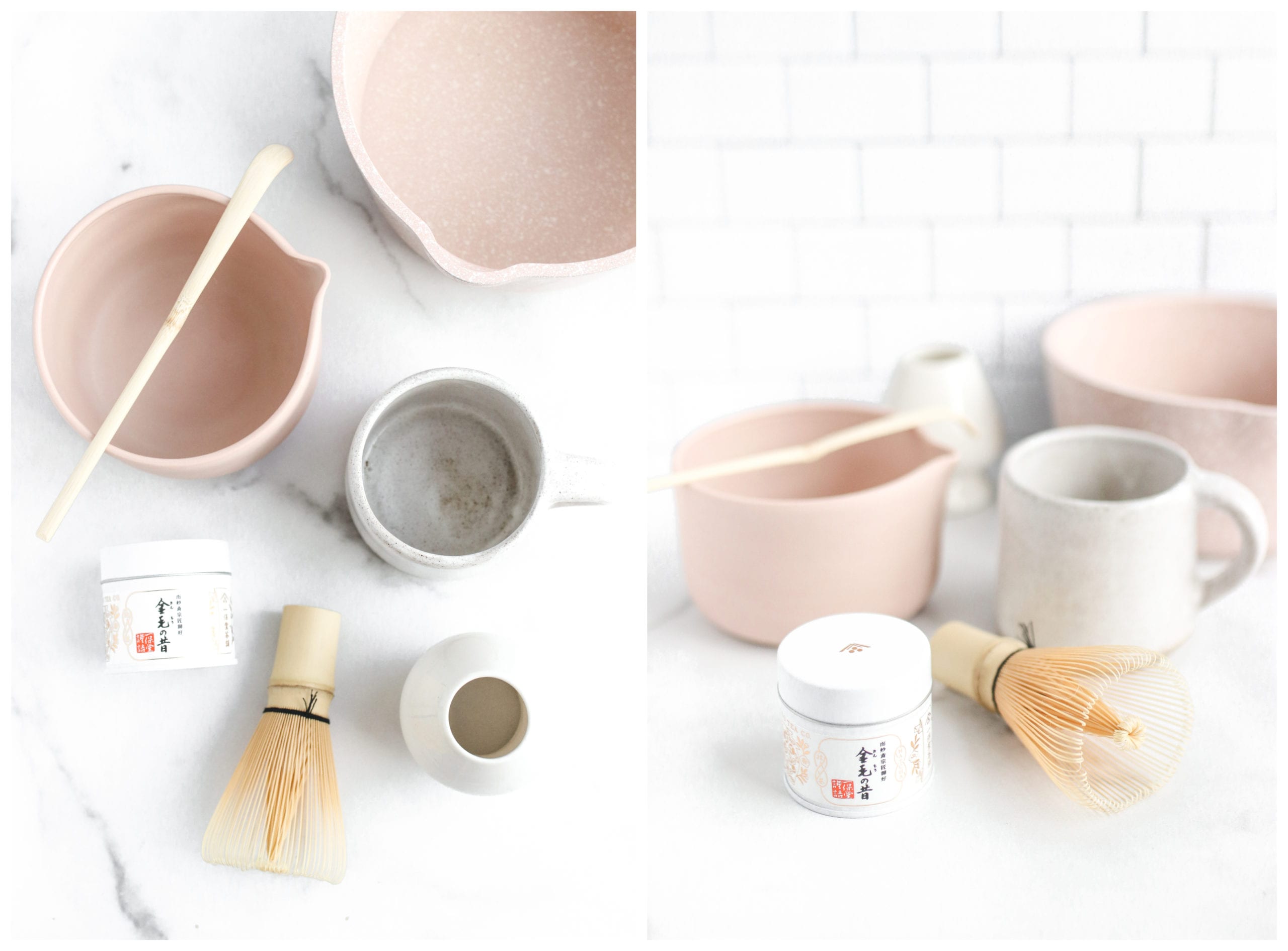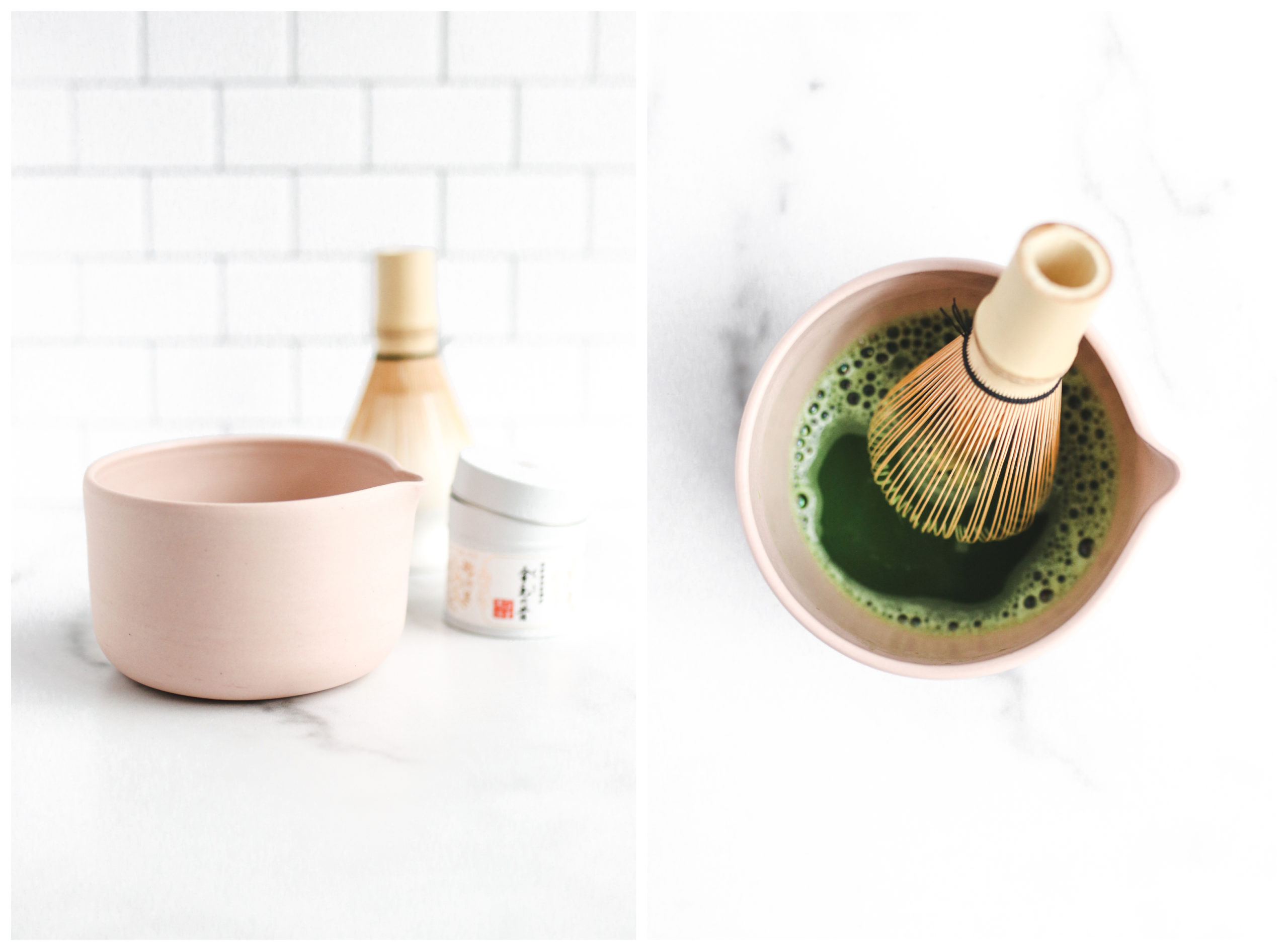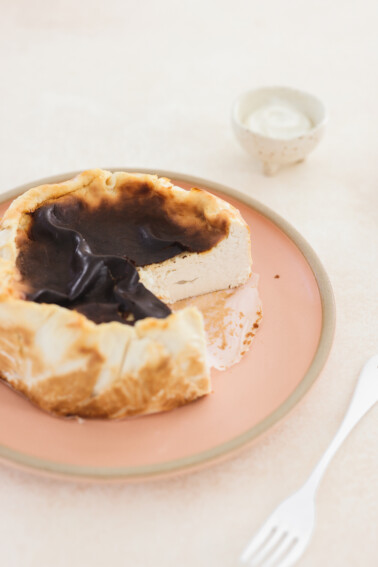This page may contain affiliate links, which means I will make a small commission for products purchased through my link.
Learn about matcha and how to make matcha right in your very own kitchen! We’re covering everything from the basics–what matcha is, different quality grades, and needed tools. Plus, I’ll share the secrets to a killer homemade matcha latte, hot or iced!

The Ultimate Guide to Matcha
Making matcha at home may seem daunting at first, but I guarantee it’s not only easy to do but also the best way to enjoy it. At cafés, you’re paying a premium for a poorly whisked latte and a high probability of clumps at the bottom of the drink. You’ll not only save yourself some money but will probably end up with a much tastier latte!
Nowadays, matcha is becoming more and more popular, but it’s important to note that not all matcha is good. Yup! I said it. Growing up, I would drink it with my oba-chan (grandma, in Japanese), and when I tried my first Starbucks matcha, I was so surprised by what I tasted. My standards are definitely up there, but the contrast between good and bad can make all the difference.
Think about it like you would coffee. There’s such a wide range of blends, roasts, and types of coffee you can enjoy. So, before you decide you’re not a fan of it, make sure you give a really good matcha a shot first.
I’m going to walk you through the entire process of making it at home, including how to find quality matcha powder and what tools you need.
What is Matcha?
Matcha is simply the result of grinding green tea leaves into a fine powder. It differs from regular green tea in that you’re consuming the entirety of the leaves versus just steeping tea leaves. Naturally, the flavour is much more intense and bold. It also has a vibrant green color, making it stand out amongst other teas and beverages.
The consumption actually originated in China. However, it was brought by Myoan Eisai, Japanese Buddhist monks, back to Japan in the 12th century, where it was then popularized. As it gained popularity in Japan, it became an integral part of Japanese culture. Today, matcha is enjoyed as part of Japanese Tea Ceremonies, also known as chado.
Varieties of Green Tea
Matcha green tea actually comes from the same tree as sencha, gyokuro, genmaicha, houjicha, green tea, and even oolong and black tea. The difference comes from the time of harvest as well as the processing and fermentation methods, which influence the variety you end up with as well as the price and quality.
- The first harvest yields tea leaves appropriate for sencha, which is a brewed tea and ceremonial matcha. This is the highest quality matcha.
- Later in the summer, the second harvest yields culinary matcha, which is less nutrient-rich (as it is the second harvest of the year) and, therefore, a lower grade of matcha.
- Finally, the third harvest is typically used for commercial drink products, like bottled tea.
Tea leaves for matcha require a very specific climate to be grown. They are shade-grown, most commonly in mountainous tea regions in Japan like Shizuoka, Uji, Wazuka, and Kagoshima. What makes these regions ideal for tea growing is the access to shade and mineral-rich soil. Shade and/or fog are important when growing antioxidant-rich tea because exposure to too much sunshine imparts bitterness.
Right after harvest, green tea leaves are steamed, and then fermentation is stopped. They are then dried several times by machines to remove the moisture and finely ground into a powder.

Caffeine in Matcha vs. Coffee
One of the most common questions is about how the caffeine content compares to the caffeine content in a cup of coffee. Most people do not realize that the caffeine content in a serving of matcha can actually be equivalent to and sometimes higher than the caffeine content in one serving of coffee.
On average, an 8oz serving of matcha can contain about 25-75mg of caffeine, but the caffeine tends to be much more tolerable than in coffee. This is because of L-theanine, which aids in the slower, sustained release of energy with no sudden crash. For this reason, Buddhist monk Eisai described the feeling matcha provided as a “calm alertness.” Basically, “less caffeine” is not accurate, more like “better caffeine.” 🙂
In addition to L-theanine, matcha contains EGCG (epigallocatechin gallate), a powerful catechin, chlorophyll, and more.
Matcha Health Benefits
Matcha is commonly advertised for its potential to prevent cancer and neutralize free radicals in the body. It is said to aid in weight loss as a metabolism booster as it supports sustained energy levels. All of these potential health benefits are tied to the amino acids mentioned above.
Culinary Grade Matcha vs. Ceremonial Grade Matcha
The difference between culinary grade matcha and ceremonial grade matcha powder comes down to price and quality. As mentioned earlier, culinary comes from the second harvest of the year, whereas ceremonial grade is the premium, first harvest.
The flavour difference and colour difference can be stark between the two. You may notice that culinary powder can take on almost a yellow/brown and very dull green colour whereas ceremonial grade is rich, vibrant, and deep in green colour. Culinary tends to be much more bitter and can even have a slight fishy taste to it.
My recommendation for anyone drinking matcha would be to drink high-quality matcha– ceremonial grade. You will not only be consuming the most nutrient but also the best flavour and colour. Even though the name “culinary” may suggest that it is better for cooking purposes, the colour and flavour are much duller, so I would still recommend a ceremonial grade version.
One very important tip I’ll share with you is that ceremonial-grade matcha can still vary in its quality. As long as it is harvested first and processed correctly, it could be ceremonial. Still, you want to make sure you’re purchasing from tea families specializing in proper growing and processing.
One last thing to note: matcha powder should contain only one ingredient–matcha. Look out for powders with added cornstarch or wonky ingredients.
Where to Buy Quality Matcha
I purchase the majority of my matcha from Ippodo tea, which is a traditional Japanese family-owned brand over 300 years old. The tea is grown in Kyoto, which is a region known for producing the best quality.
My oba-chan turned me onto my favorite brand, Ippodo, and they have a great selection of different kinds of matcha. They also list their varieties from richer to lighter and taste notes for each type.
Other brands I enjoy include Kettl and Matchaful.
Is Organic and Third-Party Tested Matcha Important?
Because you’re consuming the whole leaf, it can be important to look for an organic tea. One thing to know is that in Japan, there is something called JAS certification, but it is not recognized by the FDA in the United States. If you see JAS, you can rest assured even if “organic” is not printed on the label.
Many families in the tea-growing regions do not want to pay for JAS or FDA organic certifications despite the fact that they are not using any pesticides and are growing by the guidelines, so ultimately, it is up to you. If you’re drinking it daily, it could be good to consider.
As it is grown in Japan, radiation contamination, lead, and chemical pesticides are concerns, so most matcha is third-party tested.
How to Store Your Matcha
As we know, matcha is sensitive to the sun! It is, therefore, typically packaged in metal tins or opaque paper bags to keep the sun out. For best freshness, you can also store it in the fridge or freezer, and it’s common to find a silica packet or other drying agent in your tin of matcha to keep out any moisture. When using, be sure to close the lid right after use and always keep it dry. You can store it in a cool, dark place in your kitchen if you don’t want to refrigerate or freeze it.
It’s best not to purchase large quantities at once because the freshness tends to fade, but if you find yourself not able to make it through your supply fast enough, then the fridge/freezer is your best friend.
Delicious Matcha Recipes
I share below how to make the best matcha latte, but if you’re anxious to make the perfect cup of matcha right this second, here are different ways to do it!
Must-Have Tools
The basic tools I recommend using are listed below. Ippodo carries a great selection of matcha tools as well, which are made to last when cared for properly. I’ll also include a few fun items that are not necessities but nice-to-haves.
These tools do absolutely change the end result of your drink, so if you’re asking yourself if it’s worth it, my answer would generally be yes! Investing in all of your tools and a good matcha powder usually ends up saving you money when compared to buying a matcha latte at a cafe regularly.
Bamboo Tea Ladle or Scoop
This will provide the perfect serving and is a beautiful traditional tool. If you prefer, you can scoop matcha powder by the teaspoon as well (typically 1 tsp-2 tsp per serving). This tool is also important for pushing your matcha through your tea sifter.
Tea Sifter

This tool is the first step to removing clumps. Matcha powder naturally will clump as it sits together, so breaking it up initially is key. If you don’t have a tea sifter, you can also dry whisk the powder with the bamboo whisk to help remove clumps too. I did this when my tea sifter was broken, and it works alright as a substitute. I recommend against skipping this step as it will help to aerate your tea, too.
Bamboo Whisk
A tool essential for whisking out clumps properly and also adding froth to your drink. A whisk with a higher count of threads will be more effective. Some people like to use an electric whisk, milk frother, blender, or even a metal cooking whisk, but I have tested all methods out and stand by the bamboo whisk is the best tool! There’s a reason why it’s used in Japan 😉
Whisk Stand

This is a tool I think is worth investing in. Bamboo whisks can mold if not dried properly and crack or dry out of shape. To take proper care of your matcha whisk, rinse and clean it after use and then store it on a stand to preserve its shape as it dries. You can also watch this video for more information on proper whisk care.
Tea Bowl (Chawan)

You can use most bowls to whisk your tea, but I recommend one with higher walls so you can whisk without fear of spilling. I always like to use a bowl with a spout to make pouring easier.
How to Make Matcha at Home
Once you have a high-quality powder and the right tools to work with, you can begin to make the perfect cup of matcha. The basic process for preparing the matcha is the same for most drinks (whether a hot or iced matcha latte, simple iced matcha, or even a fancy mixed drink). You can compare it to preparing a shot of espresso–the fun happens after the shot is ready!
- Heat roughly 1/4 cup of water per serving over a stovetop or in a kettle, and remove from heat just before it boils. Aim for hot, but not boiling, water.
- Place your tea sifter over your bowl, and sift a serving of matcha powder, roughly 1-2 tsp, over the tea sifter. Use the back of the ladle to push the powder through the sifter into the bowl.
- Pour hot water into the bowl and make back-and-forth motions with your bamboo whisk (an M shape), being sure to whisk to cover all of the surface area. Whisk until no clumps remain, and the matcha is slightly frothy.
- Enjoy as is, and add hot or iced water to drink it straight. For a latte, add warmed milk or milk and ice cubes and enjoy. If you like your matcha lightly sweetened, you can add sweetener as desired. I recommend using a liquid sweetener or making a simple syrup with the sugar of choice for best results.
How Much Milk? How Much Water?
I am often asked what the right ratio of water to tea or tea to milk is. The answer is it will vary by person, so experiment and see what you enjoy best!

Think of it like coffee–do you prefer a milkier, creamier latte or something lighter and grassier? If you like it sweet, add sweetener! Make this matcha latte recipe your own!
Because I’m vegan, I love using coconut milk, vanilla almond milk, soy milk, maple syrup, vanilla extract, and other vegan ingredients to play around with, making the best matcha latte I can! Have fun with it while you figure out your perfect cup!
Other Ways to Enjoy Matcha
Once you have the basics down, you can start to experiment with ways to enjoy. Incorporate into your favorite desserts, ice cream, drinks, and more! Here are some of my favorite tea-infused recipes you can try:
- Matcha Latte Gummy Bears
- 3-Ingredient Matcha Dusted Chocolate Almonds
- Matcha Butter Mochi Cake
- Matcha Martini Mocktail
If you try these tips, tag me on Instagram @veggiekins so I can see what you whisk and for a chance to be featured! As always, I love when you share your reviews in the comments below, and if you found this guide helpful, please let me know!





22 Comments